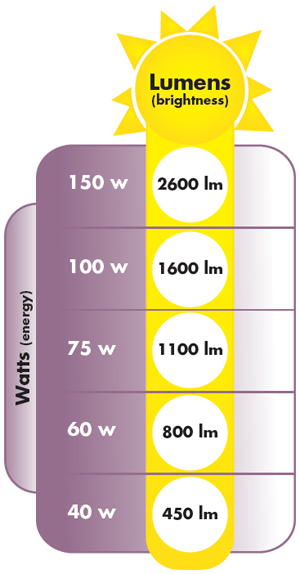Characteristics of Light

Estimates base on typical incandescent bulbs
This chart shows the number of lumens produced by common incandescent bulbs.
A Guide to Lamp Brightness: Lumen Scale
In the past, consumers have used wattage to rate the brightness of a lamp. However, wattage is not an accurate indicator of lamp brightness. Energy efficient light sources such as Compact Fluorescent Lamps (CFL) have much lower wattages while still producing a great amount of light. Wattage is simply a measure of the amount of energy consumed. Light output, on the other hand, is a measure of luminous flux or simply put, the brightness of the lamp. It is measured in LUMENS.
As more consumers become aware of this common misconception, lumens will become one of the most important factors in lamp selection.
So, if you're still asking WATT lamp you need, you're asking the wrong question.
Just remember, more lumens = more light.
The guide at right shows typical LUMEN ratings for incandescent lamps.
Color Rendering Index
CRI, or Color Rendering Index (Ra), measures how well a given light source will render color. Scientists evaluate this by using 8 reference colors and comparing how they look under the light source to how those same colors appear under two reference sources: incandescent light (for warm color lamps) and daylight (for cool color lamps). CRI is represented by a number on a scale from 0 to 100 with 0 being "poor" and 100 being "excellent". The lower the number, the more distorted a color will look under the light source. As you can see in these two pictures, a light source has the ability to enhance or distort the colors of an object.
-
 Poor CRI
Poor CRI
-
 Good CRI
Good CRI
Correlated Color Temperature: Warm or Cool
Color appearance, also known as Correlated Color Temperature (CCT), is a measure of how warm or cool a light source appears to the human eye. It is measured in degrees Kelvin.
The majority of light sources have a Kelvin temperature within the range of 2700K to 6500K. As a point of reference, daylight at noon has a Kelvin temperature of 5000K. Incandescent light sources typically range from 2700-3500K. Compact Fluorescents and LEDs can range from 2700-6500K. The higher the Kelvin temperature, the cooler the light source appears and the lower the Kelvin temperature, the warmer the light source appears.

